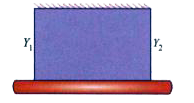Two vertical rods of equal lengths, one of steel and the other of copper, are suspended from the ceiling at a distance l apart and are connected rigidly to a rigid horizontal bar at their lower ends. If AS and AC be their respective cross-sectional areas, and YS and YC,their respective Young's moduli of elasticities, where should a vertical force F be applied to the horizontal bar in order that the bar remains horizontal?

l1−(AS/AC)(YS/YC)
2l1+(AS/AC)(YS/YC)
l(AS/AC)(YS/YC)
l1+(AS/AC)(YS/YC)
The correct Answer is:D
Let the force F be applied at a distance x from the steel bar, measured along the horizontal bar. Let FS and FC be the loads on steel and copper rods, respectively then
FS+FC=F......(i)
(ii) since the rigid horizontal bar remains horizontal, the extensions produced in the two rods and hence strians remain the same. That is
FSASYS=FCYC.......(ii)
Solving Eqs.(i) and (ii) we get,
FS=FASYSASYS+ACYC and FC=FACYCASYS+ACYC
Now, taking moments about the steel bar,
FCl=Fx,x=FCFl=ACYClASYS+ACYC
or x=l1+(AS/AC)(YS/YC)
Topper's Solved these Questions
- MECHANICAL PROPERTIES OF SOLIDSBook:NARAYNAChapter:MECHANICAL PROPERTIES OF SOLIDSExercise:Comprehension-1:
Explore 2 Videos
- MECHANICAL PROPERTIES OF SOLIDSBook:NARAYNAChapter:MECHANICAL PROPERTIES OF SOLIDSExercise:Comprehension-2:
Explore 2 Videos
- MECHANICAL PROPERTIES OF SOLIDSBook:NARAYNAChapter:MECHANICAL PROPERTIES OF SOLIDSExercise:COMPREHENSION TYPE
Explore 11 Videos
- MECHANICAL PROPERTIES OF FLUIDSBook:NARAYNAChapter:MECHANICAL PROPERTIES OF FLUIDSExercise:EXERCISE - III
Explore 30 Videos
- MOTION IN A PLANEBook:NARAYNAChapter:MOTION IN A PLANEExercise:Level-II(H.W)
Explore 31 Videos
Similar Questions
A horizontal rod suspended from two wires of same length and cross - section. Their Young's modulus are Y1 and Y2 respectively. The equivalent Young's modulus will be

View SolutionA composite tube is made by strinking a thin steel tube on a nras tube. If AS and AB are the respective sectional areas of the steel and brass tubes and YS and YB their Young's moduli, then find the Young's modulus of single tube of the same length and total sectional area, which would be have in the same facition as that of the composite tube.
View Solution
Knowledge Check
A smooth uniform string of natural length L0, cross-sectional area A and Young's modulus Y is pulled along its length by a force F on a horizontal smooth surface. The elastic potential energy stored in the string is
A2F2L0AYBF2L02AYCF2L02AYDF2L06AYA mass (m) is suspended at the end of a weightless wire of length L, cross-sectional area A and Young's modulus Y. The period of oscillation for the S.H.M. along the vertical direction is
A2π√YAmLB2π√mLYAC2π√mYALD2π√ALmYA uniform steel bar of cross-sectional area A and length L is suspended, so that it hangs vertically. The stress at the middle point of the bar is (ρ is the density of stell)
AL2AρgBLρg2CLAρgDLρg
A wire of length l, area of cross section A and Young’s modulus of elasticity Y is stretched by a longitudinal force F. The change in length is Δl Match the following two columns.

View SolutionA copper rod length L and radius r is suspended from the ceiling by one of its ends. What will be elongation of the rod due to its own weight when and Y are the density and Young's modulus of the copper respectively?
View SolutionA smooth uniform, string of natural length l, cross-sectional area A and Young’s modulus Y is pulled along its length by a force F on a horizontal surface. Find the elastic potential energy stored in the string.
View SolutionA uniform bar of square cross-section is lying along a frictionless horizontal surface. A horizontal force is applied to pull it from one of its ends then

View SolutionAn iron bar of length L, cross-section area A and Young's modulus Y is pulled by a force F from both ends so as to produce an elongation l . Which of the following statements is correct?
View Solution

